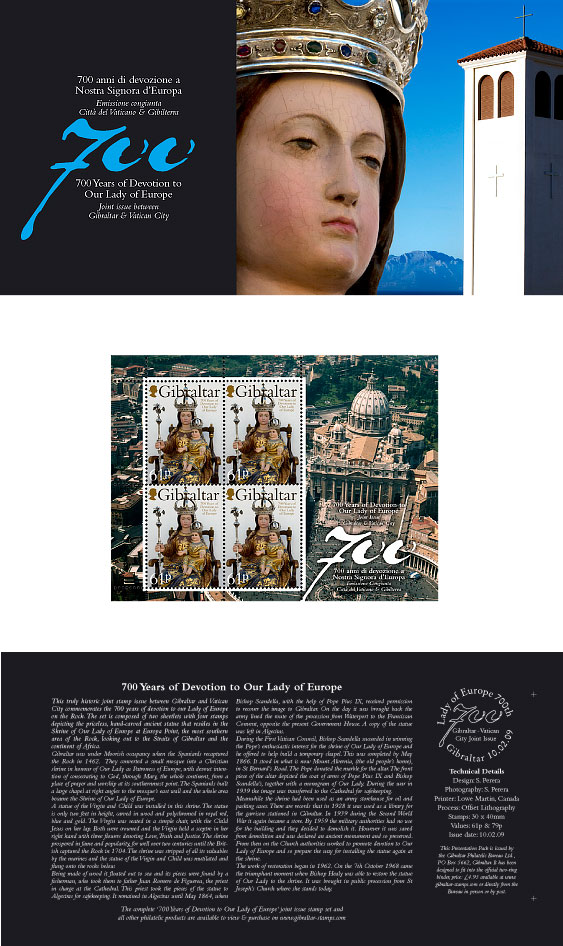Home -> Stamps -> 2009 -> Gibraltar-Vatican Joint Issue -> Pack Miniature Sheet
We also recommend:
Gibraltar-Vatican Joint Issue

Gibraltar-Vatican Joint Issue (view technical specs)
This truly historic joint stamp issue between Gibraltar and Vatican City commemorates the 700 years of devotion to our Lady of Europe on the Rock. The set is composed of two sheetlets with four stamps depicting the priceless, hand-carved ancient statue that resides in the Shrine of Our Lady of Europe at Europa Point, the most southern area of the Rock, looking out to the Straits of Gibraltar and the continent of Africa.
Gibraltar was under Moorish occupancy when the Spaniards recaptured the Rock in 1462. They converted a small mosque into a Christian shrine in honour of Our Lady as Patroness of Europe, with devout intention of consecrating to God, through Mary, the whole continent, from a place of prayer and worship at its southernmost point. The Spaniards built a large chapel at right angles to the mosque’s east wall and the whole area became the Shrine of Our Lady of Europe.
A statue of the Virgin and Child was installed in this shrine. The statue is only two feet in height, carved in wood and polychromed in royal red, blue and gold. The Virgin was seated in a simple chair, with the Child Jesus on her lap. Both were crowned and the Virgin held a sceptre in her right hand with three flowers denoting Love, Truth and Justice. The shrine prospered in fame and popularity, for well over two centuries until the British captured the Rock in 1704. The shrine was stripped of all its valuables by the marines and the statue of the Virgin and Child was mutilated and flung onto the rocks below.
Being made of wood it floated out to sea and its pieces were found by a fisherman, who took them to father Juan Romero de Figueroa, the priest in charge at the Cathedral. This priest took the pieces of the statue to Algeciras for safekeeping. It remained in Algeciras until May 1864, when Bishop Scandella, with the help of Pope Pius IX, received permission to recover the image to Gibraltar. On the day it was brought back the army lined the route of the procession from Waterport to the Franciscan Convent, opposite the present Government House. A copy of the statue was left in Algeciras.
During the First Vatican Council, Bishop Scandella succeeded in winning the Pope’s enthusiastic interest for the shrine of Our Lady of Europe and he offered to help build a temporary chapel. This was completed by May 1866. It stood in what is now Mount Alvernia, (the old people’s home), in St Bernard’s Road. The Pope donated the marble for the altar. The front piece of the altar depicted the coat of arms of Pope Pius IX and Bishop Scandella’s, together with a monogram of Our Lady. During the war in 1939 the image was transferred to the Cathedral for safekeeping.
Meanwhile the shrine had been used as an army storehouse for oil and packing cases. There are records that in 1928 it was used as a library for the garrison stationed in Gibraltar. In 1939 during the Second World War it again became a store. By 1959 the military authorities had no use for the building and they decided to demolish it. However it was saved from demolition and was declared an ancient monument and so preserved. From then on the Church authorities worked to promote devotion to Our Lady of Europe and so prepare the way for installing the statue again at the shrine.
The work of restoration began in 1962. On the 7th October 1968 came the triumphant moment when Bishop Healy was able to restore the statue of Our Lady to the shrine. It was brought in public procession from St Joseph’s Church where she stands today.
Technical Specs
| Design: | Stephen Perera |
| Illustration / Photography: | Stephen Perera + The Vatican |
| Printer: | BDT International, Ireland |
| Process: | Offset Lithography |
| Colours: | 4 cols. |
| Stamp size: | 30 x 40mm |
| Issue date: | 2009-02-10 |
| Stamp Values: | 61p, 0,85 euros |













